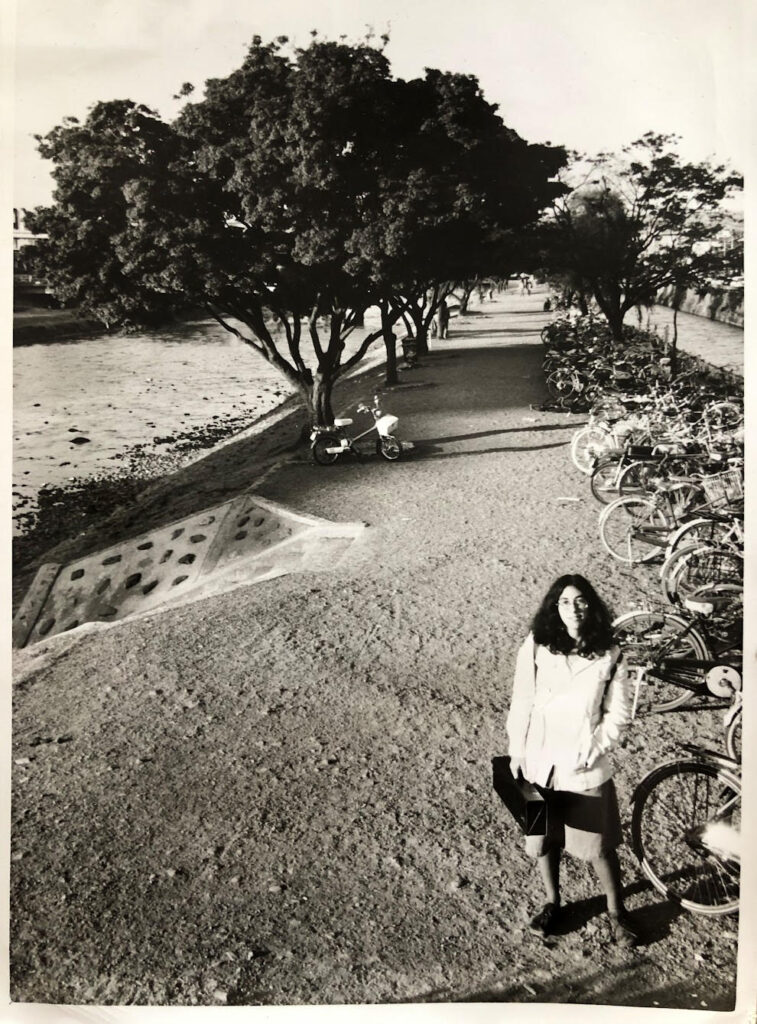[The author was a member of the 1976 Associated Kyoto Program and this was her first, but certainly not her last, visit to Kyoto. This is an excerpt from her memoir in progress on learning to read with the counterculture in Kyoto.]

The three of us Midwesterners had become close friends quickly. We’d experienced the group orientation of our program together and privately figured we were one step ahead of the others in navigating Kyoto. We were finding our “places” for quick meals and just hanging out after or between classes. And we thought we fit in just fine at Honyarado. It was just down the street from Doshisha University where our program was located. We liked the music. We could count on hearing Bob Dylan and the Grateful Dead there. And we’d climbed the creaky staircase to the right of the wooden front door and discovered the second floor which held a big table and walls of bookshelves.
Of course, with just a year or two of the Japanese language under our belts, we couldn’t read any of the books so we ignored them and instead spread out our own textbooks to study. I loved being surrounded by books and my eyes often wandered over to the shelves. I wished that I could magically wake up with the ability to read in Japanese. But, it would take years before that happened.
One day there was a cute older guy upstairs with us sitting in the corner immersed in a book, his long legs propped up on a folding chair. He ignored us and we ignored him. We’d gotten used to talking about any old thing at all rather blithely in front of Japanese people. The chances that they’d understand our rapid-fire English were close to zero. So, yes, we discussed him. In fact we dissected him to pieces. One of my friends was really interested in him. He yawned unknowingly.
As the days got shorter I became more adventurous about going out on my own. I’d been in Kyoto just a few short months. I knew what bus to take downtown and it was fun to explore. I’d discovered that everything was open on Sundays, a day we had off from school. One Sunday I was walking down Shjodōri and I saw an antique shop. It was a little daunting to go in, but when I did I saw something that was new to me. I’d been missing music in my life and this was a little koto. Later I found out that it was called a taishōgoto. I rashly made a purchase. I was excited and feeling confident.
When I walked out of the store and went back to the Shijo Kawaramachi intersection, I saw someone who looked familiar. At first, I couldn’t quite place him, but he smiled at me and then it clicked. He worked at Honyarado. The guy who took all the photos. Out of context, it had been hard to recognize him. But he recognized me easily. He came up to me and we started talking. Or rather we attempted talking. Between my limited Japanese and his limited English conversation was almost impossible. He invited me to walk back to Honyarado with him. Or more likely he indicated the direction he was heading which was the same direction as I needed to go since my homestay family lived just a few blocks from Honyarado. Since it was a Sunday evening I didn’t need to be home for dinner that night. So we walked and I watched him as he snapped photo after photo.
When we got to Honyarado, it was almost empty. The photographer quickly went behind the counter and got me a cup of coffee. I was confused. I hadn’t ordered it. Was this hospitality or business for him? He got himself a cup of coffee as well and called upstairs to someone to come down. It was the cute guy that my friend was crushed out on. Cute Guy swung his legs over the bench on the other side of the table and sat down next to the photographer. He introduced himself in almost flawless English. Oops. Wait until I tell the others, I immediately thought. He had probably understood every word we’d said about him. This was going to be embarrassing. He was a professor at Seika University (then Seika Junior College). In fact, years later he’d become the president of the university.
The photographer had thoughtfully (and necessarily) called him over to interpret. WIth the professor in the middle, we could communicate easily and the photographer had a lot of questions. Being there in the evening when it was mostly staff milling about was exciting. I was the only foreigner in the room and I felt like I’d made an entry to a whole other world. Probably I had, but I didn’t really know the full impact of this until much later. After awkwardly trying to pay for the coffee and having my money rejected, I went home feeling excited. I’d promised to meet the photographer again at 10 AM by the river the next day. After all, why not?
*************************
Learn more about Sara’s life in Japan here. Visit her book review site here.

